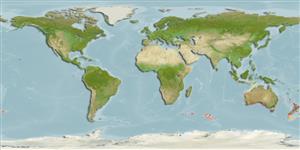>
Trachichthyiformes (Roughies) >
Trachichthyidae (Slimeheads)
Etymology: Hoplostethus: Greek, hoplon = weapon + Greek, stetho, stethion = brest; literal = to prick a little breast (Ref. 45335).
Eponymy: Gigas was a giant in Greek mythology, the child of Uranus and Gaea. The name is applied to taxa that are giants of their kind. (Ref. 128868), visit book page.
Environment: milieu / climate zone / depth range / distribution range
Ekologi
marina djupbottenlevande; djupintervall 237 - 311 m (Ref. 58018). Deep-water
Eastern Indian Ocean: western and southern coasts of Australia. Southwest Pacific: New Zealand (Ref. 5755).
Size / Vikt / Age
Maturity: Lm ? range ? - ? cm
Max length : 52.5 cm SL hane/ej könsbestämd; (Ref. 9872)
Found on the continental slope (Ref. 75154).
Life cycle and mating behavior
Könsmognad | Reproduktion | Lek | Ägg | Fecundity | Larver
Kotlyar, A.N., 1980. Systematic and distribution of trachichthyid fishes (Trachichthyidae, Beryciformes) of the Indian ocean. Trudy Inst. Okeanol. 110:177-224. (Ref. 9872)
IUCN Red List Status (Ref. 130435: Version 2024-2)
Threat to humans
Harmless
Human uses
Verktyg
Special reports
Download XML
Internet-källor
Estimates based on models
Preferred temperature (Ref.
123201): 8.6 - 12.8, mean 11.1 °C (based on 23 cells).
Phylogenetic diversity index (Ref.
82804): PD
50 = 0.5000 [Uniqueness, from 0.5 = low to 2.0 = high].
Bayesian length-weight: a=0.01660 (0.00714 - 0.03859), b=3.05 (2.85 - 3.25), in cm total length, based on LWR estimates for this (Sub)family-body shape (Ref.
93245).
Trofisk nivå (Ref.
69278): 3.7 ±0.6 se; based on size and trophs of closest relatives
Resiliens (Ref.
120179): Mycket låg, lägsta populationsfördubblingstid mer än 14 år (Preliminary K or Fecundity.).
Fishing Vulnerability (Ref.
59153): Moderate to high vulnerability (46 of 100).
